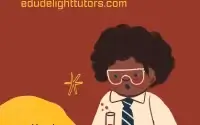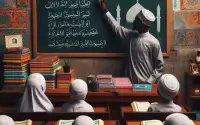Revision and Review Test Questions Cultural and Creative Arts JSS 3 First Term Lesson Notes Week 11
Week 11 Revision of All Topics Covered
Week 11: Revision
Topic: Revision of First Term Content
Overview:
This week is dedicated to reviewing and consolidating the knowledge and skills learned throughout the first term. The revision session will cover key concepts, topics, and practical activities to prepare students for their upcoming examinations.
Objectives:
By the end of this revision week, students should be able to:
- Recall and explain key concepts covered in the first term.
- Demonstrate understanding of various topics through discussion and practice.
- Prepare effectively for the examination by reviewing relevant materials and topics.
Revision Plan:
- Review of Key Topics:
- Week 1: Nigeria Traditional Art
- Definition and types (Nok, Ife, Benin)
- Week 2: Identification of Palaces of Origin of Each Art
- States of origin and functions of traditional arts
- Week 3: Contemporary Nigerian Art/Artists
- Definition and contributions of pioneer artists (Aina Onabolu, Akinola Lasekan, etc.)
- Week 4: Nigerian Contemporary Art Works
- Notable works and their locations
- Week 5: Motif
- Definition and types of motifs
- Week 6: Uses of Motifs and Its Application
- Various applications in art and design
- Week 7: Display Techniques
- Methods of preparing and displaying artwork
- Week 8: Exhibition
- Types of exhibitions and their purposes
- Week 9: Excursion
- Insights gained from the gallery and museum visit
- Week 10: Lettering
- Definition, types, uses, and construction of letters
- Week 1: Nigeria Traditional Art
- Interactive Activities:
- Group Discussions: Break students into small groups to discuss each topic, encouraging them to share their insights and clarify doubts.
- Quizzes: Conduct quizzes to test students’ knowledge on key concepts from the term.
- Practical Demonstrations: Allow students to practice skills such as lettering construction, motif design, or display techniques.
- Question and Answer Session:
- Allocate time for students to ask questions about any topics they find challenging, ensuring that they feel confident before the exam.
Materials Needed:
- Revision notes and handouts from previous lessons
- Art supplies for practical demonstrations (papers, pencils, markers)
- Quiz materials
Evaluation:
- Participation in group discussions and quizzes.
- Completion of any assigned revision activities or worksheets.
- Self-assessment of understanding and areas needing further review.
Part A: Review and Revision (FAQs)
- What is lettering?
Lettering is the art of creating letters and text in an artistic way. - Why is lettering important in art?
Lettering helps to communicate messages clearly and adds beauty to written work. - What are the types of letters?
The main types are serif, sans-serif, script, and decorative letters. - What is a motif?
A motif is a repeated design or pattern used in art. - How are motifs used in traditional art?
Motifs decorate items like textiles, pottery, and buildings to enhance their beauty. - Who is Ben Enwonwu?
Ben Enwonwu was a famous Nigerian artist known for his sculptures and paintings. - What is contemporary art?
Contemporary art is art created in the present time, often reflecting current issues and ideas. - What are display techniques?
Display techniques include methods like framing and mounting artwork for public viewing. - What is an exhibition?
An exhibition is an event where artists show their work to the public. - What is the difference between a solo exhibition and a group exhibition?
A solo exhibition features one artist’s work, while a group exhibition includes multiple artists. - Why do we study cultural and creative arts?
It helps us understand our culture and encourages creativity. - What is the significance of motifs in design?
Motifs enhance the visual appeal and meaning of the artwork. - How can contemporary art generate income?
Artists can sell their works or get commissions for projects. - What materials are used for lettering?
Common materials include pens, brushes, paper, and digital tools. - What is the role of a gallery?
A gallery showcases artworks and helps artists reach a wider audience. - How does a museum differ from a gallery?
Museums often focus on preserving history, while galleries emphasize exhibiting art. - What are some common uses of lettering?
Lettering is used in signs, posters, and educational materials. - What is an excursion in art education?
An excursion is a field trip to places like galleries or museums to learn about art. - What is the main purpose of art exhibitions?
The main purpose is to display art to the public and engage viewers. - How do motifs relate to cultural identity?
Motifs can express cultural values and traditions through visual representation.
Part B: Objective Questions (Fill-in-the-Blank)
- Lettering is used to create _______ text and messages. (a) beautiful (b) plain (c) boring (d) unclear
- A _______ is a repeated design in art. (a) color (b) line (c) motif (d) shape
- The _______ font has small lines at the ends of strokes. (a) sans-serif (b) decorative (c) script (d) serif
- An exhibition can be _______ or commercial. (a) public (b) private (c) local (d) national
- A _______ exhibition features the work of multiple artists. (a) solo (b) group (c) non-commercial (d) commercial
- The letter “T” is made with one _______ line and a horizontal line. (a) curved (b) diagonal (c) vertical (d) horizontal
- Motifs can be found in _______ art and design. (a) traditional (b) modern (c) both (d) none
- The letter “K” is formed with one _______ line and two diagonal lines. (a) vertical (b) horizontal (c) curved (d) diagonal
- The main purpose of display techniques is to _______ artwork. (a) hide (b) confuse (c) showcase (d) ruin
- _______ is an artist known for contemporary Nigerian art. (a) Aina Onabolu (b) Demas Nwoko (c) Bruce Onabrekpeya (d) All of the above
- A motif can represent a _______ idea or theme in art. (a) random (b) meaningful (c) confusing (d) boring
- Lettering is often used in _______ communication. (a) artistic (b) emotional (c) visual (d) political
- An excursion helps students learn about art in a _______ setting. (a) theoretical (b) practical (c) abstract (d) confusing
- Contemporary art often addresses _______ issues. (a) outdated (b) current (c) historical (d) irrelevant
- The letter “C” can be constructed with a _______ curve. (a) sharp (b) straight (c) soft (d) diagonal
- Sculptures are often displayed in _______ spaces. (a) private (b) public (c) closed (d) dark
- A solo exhibition focuses on _______ artist’s work. (a) multiple (b) one (c) famous (d) unknown
- Plant motifs can be found in _______ textiles. (a) modern (b) traditional (c) old (d) new
- Mounting artwork is important for _______ it properly. (a) hiding (b) displaying (c) storing (d) ruining
- The main goal of cultural arts education is to promote _______ identity. (a) national (b) personal (c) cultural (d) global
Part C: Theory Questions (Short Answer)
- What is the definition of lettering?
- Why are motifs important in traditional art?
- What types of letters are commonly used in typography?
- How can contemporary art impact society?
- What are the different display techniques for artwork?
- Describe the difference between a solo and a group exhibition.
- How does art contribute to cultural identity?
- What role do galleries play in the art community?
- Explain the process of constructing the letter “A.”
- What materials can be used for creating lettering?
- How can motifs express cultural values?
- What is the significance of excursions in art education?
- What are the common uses of lettering in everyday life?
- How can contemporary artists generate income through their work?
- Describe a famous Nigerian contemporary artist and their contribution.
- What are the benefits of visiting museums for art students?
- How can display techniques enhance the viewer’s experience?
- What is a motif’s role in modern art?
- Explain the importance of framing artwork for display.
- How can lettering improve the visual appeal of written materials?
Part D: True or False Questions
- Lettering is only for professional artists. (True/False)
- Motifs are irrelevant in modern design. (True/False)
- A solo exhibition showcases multiple artists’ work. (True/False)
- Contemporary art is created in the present time. (True/False)
- Lettering can enhance the beauty of a poster. (True/False)
- Plant motifs are not found in traditional art. (True/False)
- An excursion is a trip to learn about art. (True/False)
- Display techniques are not important for exhibitions. (True/False)
- The letter “B” has one vertical line and two curves. (True/False)
- Museums focus more on preserving art than galleries. (True/False)
- Geometric motifs are often used in abstract art. (True/False)
- The letter “X” can be formed with two diagonal lines. (True/False)
- Lettering is used only in art and not in advertising. (True/False)
- Bruce Onabrekpeya is known for his sculpture work. (True/False)
- A group exhibition features the work of only one artist. (True/False)
- Motifs can be used in fashion design. (True/False)
- A gallery is a place where art is sold. (True/False)
- Lettering has no role in education. (True/False)
- Contemporary artists often explore social issues in their work. (True/False)
- The main goal of cultural and creative arts is to discourage creativity. (True/False)
Part E: Fill-in-the-Gaps Questions (Without Options)
- Lettering is an art form that focuses on creating _______ text.
- A motif can be a design that appears _______ in various artworks.
- The _______ font is known for its decorative ends on letters.
- An exhibition allows artists to showcase their _______ to the public.
- A _______ exhibition features one artist’s work.
- Lettering is used in creating _______ materials for communication.
- The letter “E” is constructed with three horizontal lines and one _______ line.
- Motifs often carry _______ significance in art.
- Sculptural art can be found in _______ spaces like parks and museums.
- Display techniques enhance the way art is _______ to viewers.
- The letter “S” can be formed with two _______ curves.
- Excursions help students experience art in a _______ setting.
- Plant motifs can be found in _______ designs.
- Ben Enwonwu is a prominent figure in _______ art.
- The main goal of cultural arts is to promote _______ awareness.
- Framing is important to protect and _______ artwork.
- Lettering can also be used in _______ to convey messages.
- The letter “G” can be formed with a _______ curve and a straight line.
- Group exhibitions bring together works from _______ artists.
- The role of galleries is to support and promote _______ artists.
Related
Related posts:
- Exploring Prominent Nigerian Contemporary Artworks Cultural and Creative Arts JSS 3 First Term Lesson Notes Week 4
- Understanding Exhibitions: A Window to Art Cultural and Creative Arts JSS 3 First Term Lesson Notes Week 8
- Excursions: A Journey into Art and Culture Cultural and Creative Arts JSS 3 First Term Lesson Notes Week 9
- Lettering: The Art of Beautiful Writing Cultural and Creative Arts JSS 3 First Term Lesson Notes Week 10
- First Mid-Term Assessment Assessment Components Cultural and Creative Arts JSS 3 First Term Lesson Notes
Related Posts


Comprehensive Revision and Examination Guide for Basic Technology JSS 3


Islamic Religious Studies JSS 3 First Term Lesson Notes


Musical Forms: Simple forms- Binary form. Ternary form, Theme and other variation, Rondo form.
About The Author
Edu Delight Tutors
Am a dedicated educator with a passion for learning and a keen interest in technology. I believe that technology can revolutionize education and am committed to creating an online hub of knowledge, inspiration, and growth for both educators and students. Welcome to Edu Delight Tutors, where learning knows no boundaries.
